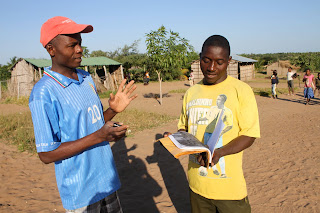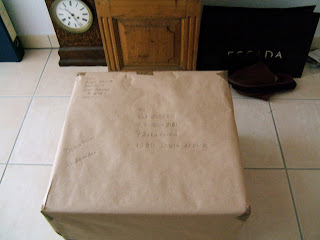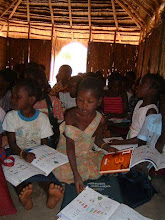We arrive at night under a star spangled sky – too tired to think of anything but sleep after eighteen hours on the road. Morning arrives early with the soft watery sound of tidal floods trickling into the mangroves. The sea is flat as glass and the sun, just up, promises a languid day.
Despite the fog of too little sleep I have to leap out of bed and into the day. Trotting eagerly down the sand steps and along the board walk – sun bleached wood hard under my feet. Bright water coasts in covering fiddler crab holes and swirling between mangrove stems clothed in barnacles and whelks. I step onto the soft white sand already dazzling in the morning sun, to greet the ocean with sleepy feet. Silky warm water washes over my toes and ankles and I drink in the scene.
Distant sailing dhows coast silently past to fishing grounds. Sunlight bounces off the ripples left by fish activity just below the surface. Hermit crabs beetle past on a meandering path to somewhere. Their tracks intertwine and converge along the shallows and I have sand in my toes again.
The Bazaruto archipelago is a jewel in the crown of Mozambique’s 3000km tropical coastline. Seen from Google earth it is a swirl of indigo and turquoise seas hemmed in by a chain of islands and an outer reef that keeps the big seas and giant sea creatures at bay.
Here poverty and wealth are rubbing shoulders like so many places in Africa. After fifteen years of war in this country the islands have become a world famous tourist destination. Ski boats race past traditional dhows on their way to trawl the fishing grounds of the reef; conservationists fight to preserve marine life, while dhow crews net the shallows endlessly day and night. Tourism has created on ongoing market for seafood – and growing families need to be fed.
Perhaps it is the contrasts in Africa that draw our attention so insistently. So many opportunities to make a real difference – so much huge potential lying in wait. Held back, in the main, by bureaucracy, human greed, and corruption – global influences that escape the common man.
We spend Sunday finding our feet, unpacking our toys – fishing gear is set out and tackled up; brightly coloured fins and goggles appear; pale bodies seek the sun; camp supplies sorted and fridges stocked.
Monday I go with Lucas, the camp manager, to Morape School. Morape is the nearest village and the one the camp staff hail from. For several years now, we have been dropping boxes of school stationary and educational material at this school – all collected by my amazing friend Angela (lettersfromusedom.blogspot.com) in Germany – paid for with monies earned from teaching English to neighbours children. The boxes are packed with exercise books, pencils, paints, toys, footballs, Portuguese text books, second hand reading glasses, first aid kits, chalk, and small bonus personal items. Into each box I add a photograph of Angela so that the teachers know who the gifts are coming from. Lucas translates for me and we ask the teacher for indicators of anything special they need for next time.
The original school house – a large thatched roof building – was blown down in the cyclone of 2007 – although the concrete base is intact and the flag pole has been re-erected at one end. It needs to be rebuilt. The school yard is an acre of sand fenced in with hand hewn poles. Within this yard are several loosely constructed shade dwellings with rows of bench seats made of poles. There are no desks as such and I wonder what the pupils lean on when doing their work. At the end of each room is a modern looking blackboard; in one room there is an impressive teacher’s desk.
Children gather round in open curiosity as the boxes are unpacked onto the concrete foundation of the old school. The teachers struggle to maintain discipline and keep children in line while books and pencils are handed out. There is much excitement – some children enjoy the camera, others look perplexed and wary; all are entirely engaging in their own way with guileless and spontaneous smiles.
Finally waving goodbye we leave the teachers to get on with their classes and wend our way on sand tracks to the beach to buy seafood from the dhows. A sleepy scene greets us. Fishing nets strung on a pole next to a monkey, tied by the waist to a tree stump in the shade of coconut palms. On seeing our interest in the monkey, a child taunts it gently to provoke interaction. The monkey bounces on his chain but never stretches the limit of its range.
Here the tidal reach is shallow. A dhow is on its way in so we walk down to meet it. Further along three figures are pulling in a net, but the catch is small and hardly replaces the energy expended on heaving in the net. We buy some calamari – strange sea creatures out of their element; fleshy soft beings with enormous blue eyes.
Perfect coastal days flee by – exploring mangroves on fishing canoes – those lovely broad ones that are so stable. With clear calm waters fish explode out of the water around us like silver bullets chased by our shadows. Snorkelling on reefs and sea grass beds where the many coloured starfish lie like cartoons dropped from above; bizarre and beguiling creatures amaze and intrigue. I have to pop my head up from time to time to be sure I am still on the same planet. Fabulous crabs that look like mobile pebbles graced with soft pink seaweed; urchins and slugs, clown fish, anenomes, and a carpet of bling from broken sand oyster shells.
In the reserve the first game introductions have started. Three zebra were released a month ago, and at the bomas, nyalla and wildebeest acclimatise to their new surroundings. Next week, more nyalla, wildebeest, waterbuck, eland and giraffe will arrive. They have been a long time coming as the Sanctuary (Vilanculos Coastal Wildlife Sanctuary – http://www.thesanctuary.co.za/) have prioritised community upliftment projects.
The moon waxes and wanes, the rhythm of the tides controls our days, and all too soon a week rushes by with the last outgoing tide. We drive through the night, taking turns at the wheel. There are people walking along the road all through the night – drunkards and partygoers make way for early risers and the workforce with never a break in-between. It is a constant stream. By morning we are back in the drought stricken interior. Hopes of rainfall in our absence are dashed. The skinny warthogs come trotting in when they hear our vehicles approach – and the monkeys return around sunset to watch for gaps in doors and windows. The coastal dream becomes a memory package to be stored and revisited at whim.
Reposted by Val ~ October 22, 2008













































